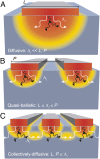A new regime of nanoscale thermal transport: Collective diffusion increases dissipation efficiency
- PMID: 25831491
- PMCID: PMC4413272
- DOI: 10.1073/pnas.1503449112
A new regime of nanoscale thermal transport: Collective diffusion increases dissipation efficiency
Abstract
Understanding thermal transport from nanoscale heat sources is important for a fundamental description of energy flow in materials, as well as for many technological applications including thermal management in nanoelectronics and optoelectronics, thermoelectric devices, nanoenhanced photovoltaics, and nanoparticle-mediated thermal therapies. Thermal transport at the nanoscale is fundamentally different from that at the macroscale and is determined by the distribution of carrier mean free paths and energy dispersion in a material, the length scales of the heat sources, and the distance over which heat is transported. Past work has shown that Fourier's law for heat conduction dramatically overpredicts the rate of heat dissipation from heat sources with dimensions smaller than the mean free path of the dominant heat-carrying phonons. In this work, we uncover a new regime of nanoscale thermal transport that dominates when the separation between nanoscale heat sources is small compared with the dominant phonon mean free paths. Surprisingly, the interaction of phonons originating from neighboring heat sources enables more efficient diffusive-like heat dissipation, even from nanoscale heat sources much smaller than the dominant phonon mean free paths. This finding suggests that thermal management in nanoscale systems including integrated circuits might not be as challenging as previously projected. Finally, we demonstrate a unique capability to extract differential conductivity as a function of phonon mean free path in materials, allowing the first (to our knowledge) experimental validation of predictions from the recently developed first-principles calculations.
Keywords: high harmonic generation; mean free path spectroscopy; nanoscale thermal transport; nondiffusive transport; ultrafast X-rays.
Conflict of interest statement
The authors declare no conflict of interest.
Figures




References
-
- Siemens ME, et al. Quasi-ballistic thermal transport from nanoscale interfaces observed using ultrafast coherent soft X-ray beams. Nat Mater. 2010;9(1):26–30. - PubMed
-
- Regner KT, et al. Broadband phonon mean free path contributions to thermal conductivity measured using frequency domain thermoreflectance. Nat Commun. 2013;4:1640. - PubMed
-
- Minnich AJ, et al. Thermal conductivity spectroscopy technique to measure phonon mean free paths. Phys Rev Lett. 2011;107(9):095901. - PubMed
-
- Koh YK, Cahill DG. Frequency dependence of the thermal conductivity of semiconductor alloys. Phys Rev B. 2007;76(7):075207.
Publication types
LinkOut - more resources
Full Text Sources
Other Literature Sources
Miscellaneous

